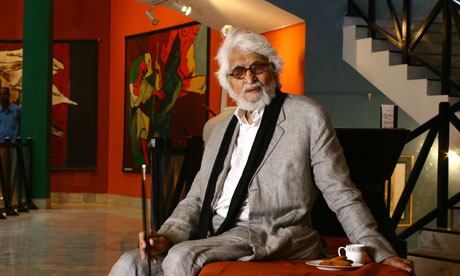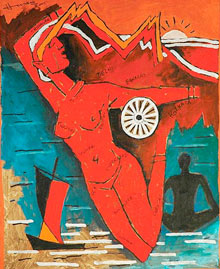
MF Husain produced up to 40,000 paintings but his defenders could do little to stem the tide of attacks.
The painter MF Husain mastered not only the techniques of line and colour, but also those of becoming a superstar of modern Indian art. Everything about him was played out on the largest scale: his obsessions with personalities such as the former prime minister Indira Gandhi, Mother Teresa or the Bollywood heroine Madhuri Dixit; his passionate incursions into Hindu religion and mythology; the size of the canvases that he loved executing in front of audiences; or his trademark style of vast, serial productions.
Phenomenal, too, were the prices of his paintings at international auctions and the energy with which the artist, in his 90s, travelled the world while an unceasing Hindu rightwing vendetta against his output prevented his return to his homeland.
A resident of Dubai since 2006, Husain moved frequently between there, New York and London, where he has died at the age of 95 after a heart attack. He had recently been working on a series sponsored by the steel magnate Lakshmi Mittal on the history of Indian civilisation from 2600BC to the present; a sequence of 99 paintings on Arabic and Islamic civilisation, commissioned by Sheikha Mozah of Qatar; and another series on his favourite subject, the history of Indian cinema.

Phenomenal, too, were the prices of his paintings at international auctions and the energy with which the artist, in his 90s, travelled the world while an unceasing Hindu rightwing vendetta against his output prevented his return to his homeland.
A resident of Dubai since 2006, Husain moved frequently between there, New York and London, where he has died at the age of 95 after a heart attack. He had recently been working on a series sponsored by the steel magnate Lakshmi Mittal on the history of Indian civilisation from 2600BC to the present; a sequence of 99 paintings on Arabic and Islamic civilisation, commissioned by Sheikha Mozah of Qatar; and another series on his favourite subject, the history of Indian cinema.

The controversial painting by MF Husain known as Bharat Mata (Mother India), though the artist maintained that the title did not come from him. That the nation's leading modern artist had to spend the last years of his life in self-imposed exile, taking Qatari citizenship in 2010, was a matter of regret to many in India. His painting of a nude Hindu goddess, Saraswati, became the target of protests in 1996. But for all their invocations of the rich precedents of nudity in India's art history and religious iconography, Husain's defenders could do little to stem the tide of attacks – notably over the internet – on more and more of his images. Further outrage followed his unclothed female figuration of the national map – the title of Bharat Mata (Mother India) did not come from him, he maintained – in 2006. Later that year, with criminal charges pending against him and threats to his life and property, the artist left India for good.
Faultlessly secular and a great promoter of Indian identity, Husain never let his Muslim background stand in the way of his celebration of what he saw as his own heritage of Hindu myth and religion. With his usual aplomb, he turned his back on his detractors and continued to paint in the name of his multireligious India elsewhere.
He often expressed his desire to go back. However, despite supreme court rulings in 2008 exonerating him, and despite the money and glamour he had brought to Indian art, propelling it to great international success, fear of controversy and vandalism stood in the way of moves to encourage his return.
Born into a large, working-class Suleimani Muslim family in the Vaishnava (Hindu) temple town of Pandharpur, now in western Maharashtra, Maqbool Fida Husain grew up with a limited formal education. He dabbled in Urdu poetry and took evening classes in painting, but his father, who for some of the time worked in a mill, and stepmother were unable to support him in taking up a place at the Sir JJ School of Art in Bombay (Mumbai).
So when he did move to the city at the age of 20, it was as a cinema hoarding painter. In 1947, the year of India's independence, the artist Francis Newton Souza invited Husain to join the Bombay Progressive Artists' Group, which provided him with an arena for the shaping of a modernist vocabulary. Opportunities to exhibit in Bombay followed, and during the 1950s Husain began to receive international recognition. Though the progressive group eventually dispersed – Souza made his career in London, and Syed Haider Raza in Paris – Husain remained steadfastly in Bombay, becoming a household name.
Awards such as the Padma Shri (1955), Padma Bhushan (1973) and Padma Vibhushan (1991) cemented his status. Abroad, he won a Golden Bear award at the Berlin Film Festival in 1967 for Through the Eyes of a Painter, and in 1971 was invited to show his works alongside those of Pablo Picasso at the São Paolo Biennale.
As well as delving into the Hindu epic poems, the Ramayana and the Mahabharata, and making capital out of many living politicians and cultural figures, Husain's projection of himself as the national artist drew him to popular outlets. These included putting his signature sketches on restaurant walls and textiles, producing nude images of female film stars, and launching his own much-hyped film ventures – Gaja Gamini with Dixit in 2000 and Meenaxi: A Tale of Three Cities with the actress Tabu in 2004 – both of which flopped at the box office.
By this late phase of his career, Husain had become to many a jaded star on the contemporary Indian art scene, with what they saw as his outdated, overdone, repetitive brand of national modernism. There were strong criticisms, in particular, of his sycophantic paintings of Indira Gandhi as the goddess Durga during the state of emergency of 1975-76, of his courting of rich patrons and of his penchant for gimmickry and showmanship.
Left to his own devices, the ageing barefoot artist would have carried on as prolifically as ever – he produced quite possibly between 30,000 and 40,000 paintings – ensconced in the past to which he belonged. But the wave of bigotry that bore down on him from the mid-1990s kept Husain in the headlines. Even after his departure, he continued to dominate the national imagination, both for those he outraged and for those who saw him as a great secular cause. Stock can now be taken of the art that he did so much to shape, while refusing to accept limitations on his freedom of expression.
Husain's wife, Fazila, whom he married in 1941, predeceased him, as did one of their children. He is survived by four sons and two daughters.
• Maqbool Fida Husain, artist, born 17 September 1915; died 9 June 2011
Faultlessly secular and a great promoter of Indian identity, Husain never let his Muslim background stand in the way of his celebration of what he saw as his own heritage of Hindu myth and religion. With his usual aplomb, he turned his back on his detractors and continued to paint in the name of his multireligious India elsewhere.
He often expressed his desire to go back. However, despite supreme court rulings in 2008 exonerating him, and despite the money and glamour he had brought to Indian art, propelling it to great international success, fear of controversy and vandalism stood in the way of moves to encourage his return.
Born into a large, working-class Suleimani Muslim family in the Vaishnava (Hindu) temple town of Pandharpur, now in western Maharashtra, Maqbool Fida Husain grew up with a limited formal education. He dabbled in Urdu poetry and took evening classes in painting, but his father, who for some of the time worked in a mill, and stepmother were unable to support him in taking up a place at the Sir JJ School of Art in Bombay (Mumbai).
So when he did move to the city at the age of 20, it was as a cinema hoarding painter. In 1947, the year of India's independence, the artist Francis Newton Souza invited Husain to join the Bombay Progressive Artists' Group, which provided him with an arena for the shaping of a modernist vocabulary. Opportunities to exhibit in Bombay followed, and during the 1950s Husain began to receive international recognition. Though the progressive group eventually dispersed – Souza made his career in London, and Syed Haider Raza in Paris – Husain remained steadfastly in Bombay, becoming a household name.
Awards such as the Padma Shri (1955), Padma Bhushan (1973) and Padma Vibhushan (1991) cemented his status. Abroad, he won a Golden Bear award at the Berlin Film Festival in 1967 for Through the Eyes of a Painter, and in 1971 was invited to show his works alongside those of Pablo Picasso at the São Paolo Biennale.
As well as delving into the Hindu epic poems, the Ramayana and the Mahabharata, and making capital out of many living politicians and cultural figures, Husain's projection of himself as the national artist drew him to popular outlets. These included putting his signature sketches on restaurant walls and textiles, producing nude images of female film stars, and launching his own much-hyped film ventures – Gaja Gamini with Dixit in 2000 and Meenaxi: A Tale of Three Cities with the actress Tabu in 2004 – both of which flopped at the box office.
By this late phase of his career, Husain had become to many a jaded star on the contemporary Indian art scene, with what they saw as his outdated, overdone, repetitive brand of national modernism. There were strong criticisms, in particular, of his sycophantic paintings of Indira Gandhi as the goddess Durga during the state of emergency of 1975-76, of his courting of rich patrons and of his penchant for gimmickry and showmanship.
Left to his own devices, the ageing barefoot artist would have carried on as prolifically as ever – he produced quite possibly between 30,000 and 40,000 paintings – ensconced in the past to which he belonged. But the wave of bigotry that bore down on him from the mid-1990s kept Husain in the headlines. Even after his departure, he continued to dominate the national imagination, both for those he outraged and for those who saw him as a great secular cause. Stock can now be taken of the art that he did so much to shape, while refusing to accept limitations on his freedom of expression.
Husain's wife, Fazila, whom he married in 1941, predeceased him, as did one of their children. He is survived by four sons and two daughters.
• Maqbool Fida Husain, artist, born 17 September 1915; died 9 June 2011
No comments:
Post a Comment